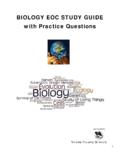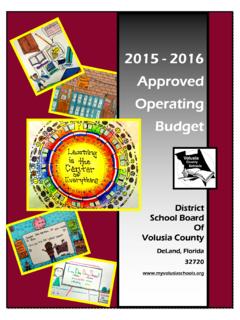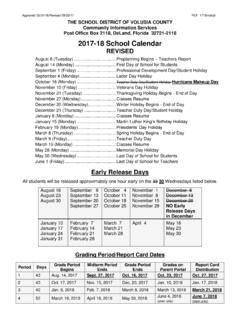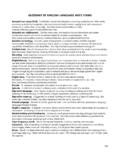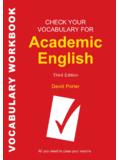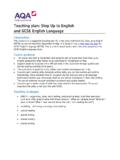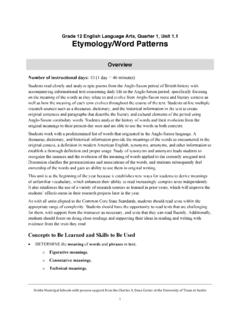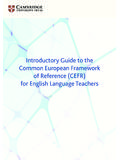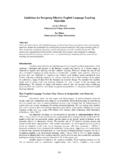Transcription of Grade 10: English 2, Regular, Honors, and Pre-IB ...
1 Grade 10: English 2, Regular, Honors, and Pre-IB . Curriculum Map The following curriculum map is based on the Language Arts Florida Standards (LAFS), which are listed at the beginning of the map and can be accessed at The main resource for the support of instruction is the Florida Collections textbook series and digital platform found at course Materials are available on Canvas located in the VPortal: Can Do Descriptors highlight what language learners can do at various stages of language development as they engage in teaching and learning in academic contexts. These can be found at . Required texts and assignments are found in the Collections listed in the table below.
2 Grade Level Quarter 1 Quarter 2 Quarter 3 Quarter 4. Collection 2: The Natural World, Collection 6: Hard-Won Liberty, Collection 3: Responses to Collection 1: Ourselves and 10 Collection 1: Ourselves and Others Collection 5: Absolute Power Change, Collection 4: How We See Things, Collection 6: Hard- Others Collection 4: How We See Things Won Liberty DIA: Assessment of Reading 2. Required PT: Write an Argument VLT 1: Argumentative Essay VLT 2: Informative Essay, PT: Narrative Writing Assessments DIA: Assessment of Reading 1. PT: Digital Media: Research The curriculum map represents what is required in any given quarter of instruction to ensure that all standards are taught as a support for learning.
3 Flexibility is given to the Grade level PLC and teachers beyond the required texts and activities to add additional resources from Florida Collections or other outside sources to best support students' learning needs. In the honors and Pre-IB English courses, teachers will provide students with additional rigorous reading and writing experiences beyond what is contained in the map. The VLT is the Volusia Literacy Test which is given two times a year to assess student success with the LAFS. The DIA is the District Interim Assessment of Reading Standards. The PT is a Performance Task which assesses student success with specific LAFS linked to a particular unit of the Florida Collections textbook.
4 During class discussion of what has been read, students should consistently be asked to find evidence from the text. This textual evidence should then be used in the students' writing, research, discussions and presentations. The study and application of vocabulary and grammar should take place within the context of what students read and write. 2018-2019 English 2, Regular and Honors, Grade 10 Curriculum Map 1. Grade 10 Language Arts Florida Standards Yearlong Learning Target Standards are bolded. These standards are highly assessed and represent major instructional shifts as required by the Language Arts Florida Standards.
5 Italicized standards are those that require instructional awareness and are woven into the reading and writing process; however, they are not formally assessed. Strand: READING STANDARDS FOR LITERATURE. Cite strong and thorough textual evidence to support analysis of what the text says explicitly as well as inferences drawn from the text. Determine a theme or central idea of a text and analyze in detail its development over the course of the text, including how it emerges and is shaped and refined by specific details; provide an objective summary of the text. Analyze how complex characters ( , those with multiple or conflicting motivations) develop over the course of a text, interact with other characters, and advance the plot or develop the theme.
6 Determine the meaning of words and phrases as they are used in the text, including figurative and connotative meanings; analyze the cumulative impact of specific word choices on meaning and tone ( , how the language evokes a sense of time and place; how it sets a formal or informal tone). Analyze how an author's choices concerning how to structure a text, order events within it ( , parallel plots), and manipulate time ( , pacing, flashbacks) create such effects as mystery, tension, or surprise. Analyze a particular point of view or cultural experience reflected in a work of literature from outside the United States, drawing on a wide reading of world literature.
7 Analyze the representation of a subject or a key scene in two different artistic mediums, including what is emphasized or absent in each treatment ( , Auden's Mus e des Beaux Arts and Breughel's Landscape with the Fall of Icarus). Analyze how an author draws on and transforms source material in a specific work ( , how Shakespeare treats a theme or topic from Ovid or the Bible or how a later author draws on a play by Shakespeare). By the end of Grade 9, read and comprehend literature, including stories, dramas, and poems, in the grades 9 10 text complexity band proficiently, with scaffolding as needed at the high end of the range.
8 By the end of Grade 10, read and comprehend literature, including stories, dramas, and poems, at the high end of the grades 9-10 text complexity band independently and proficiently. Strand: READING STANDARDS FOR INFORMATIONAL TEXT. Cite strong and thorough textual evidence to support analysis of what the text says explicitly as well as inferences drawn from the text. Determine a central idea of a text and analyze its development over the course of the text, including how it emerges and is shaped and refined by specific details; provide an objective summary of the text. Analyze how the author unfolds an analysis or series of ideas or events, including the order in which the points are made, how they are introduced and developed, and the connections that are drawn between them.
9 Determine the meaning of words and phrases as they are used in a text, including figurative, connotative, and technical meanings; analyze the cumulative impact of specific word choices on meaning and tone ( , how the language of a court opinion differs from that of a newspaper). Analyze in detail how an author's ideas or claims are developed and refined by particular sentences, paragraphs, or larger portions of a text ( , a section or chapter). Determine an author's point of view or purpose in a text and analyze how an author uses rhetoric to advance that point of view or purpose. Analyze various accounts of a subject told in different mediums ( , a person's life story in both print and multimedia), determining which details are emphasized in each account.
10 Delineate and evaluate the argument and specific claims in a text, assessing whether the reasoning is valid and the evidence is relevant and sufficient;. identify false statements and fallacious reasoning. 2018-2019 Grade 10: English 2, Regular and Honors, Curriculum Map 2. Analyze seminal documents of historical and literary significance ( , Washington's Farewell Address, the Gettysburg Address, Roosevelt's Four Freedoms speech, King's Letter from Birmingham Jail ), including how they address related themes and concepts. By the end of Grade 9, read and comprehend literary nonfiction in the grades 9 10 text complexity band proficiently, with scaffolding as needed at the high end of the range.

